 Larus cachinnans
Larus cachinnans
(last update:
Greg Neubauer
Marcin Przymencki
Albert de Jong
Mars Muusse
In 2010, Chris Gibbins, Brian J. Small and John Sweeney published two extensive papers in Britsih Birds, dealing with Caspian Gull. Below, you will find the content of the first paper "Part 1: typical birds".
The full title reads: From the Rarities Committee's files - Identification of Caspian Gull. Part 1: typical birds, by Chris Gibbins, Brian J. Small and John Sweeney, IN: BB 103/2010. ORDER PAPER COPY!
"we" in the text below refers to the original authors. If any errors occur in this text, please let me know and mail to marsmuusseatgmaildotcom.
Identification of Caspian Gull. Part 1: typical birds
Abstract
This paper deals with the identification of the Caspian Gull Larus
cachinnans. The aim is to synthesise what is currently known about the
identification of this species and discuss the appearance of proven and suspected
hybrids. The paper is split into two parts. Part 1 deals with the identification of
typical cachinnans and their separation from Herring L. argentatus and Yellow-legged L. michahellis Gulls. It is targeted at non-specialists who remain unsure of the most
reliable identification criteria, and at local records committees who need a
structured basis for assessing claims. The paper covers all age groups, but
concentrates particularly on those treated in less detail in the published literature. It includes a summary table that distils key information and ranks criteria
according to their value in field identification. Part 2, to be published in a future
issue, will deal with the identification of less typical individuals and hybrids.
Introduction
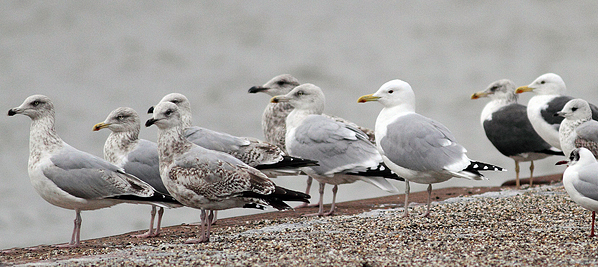
A lone Caspian Gull rests with a group of Herring Gulls in the Netherlands (January 09 2012, Utrecht, picture: Herman Bouman). Can you see it? It is white-headed, dark-eyed and is
holding its bill distinctly downwards.
Below: Larus cachinnans adult, 29 December 2011, Boulogne-sur-Mer, NW France, Picture: Jean-Michel Sauvage. White-headed bird in the centre.
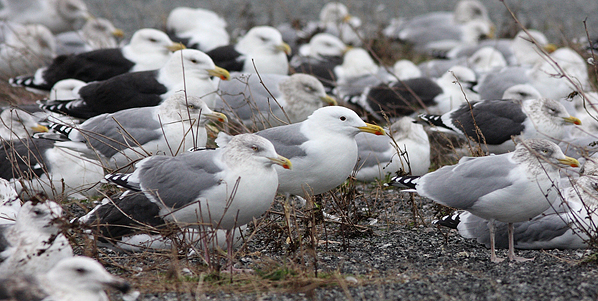
Rationale and aim
Our perception of the Caspian Gull Larus
cachinnans as a British bird has changed dramatically
in the past 20 years. It has gone
from being a poorly known, southeastern
race of Herring Gull L. argentatus (Grant 1986) to being recognised as a valid species
(Leibers et al. 2001; Collinson et al. 2008)
that regularly occurs in Britain. This transformation
has been due, in no small part, to
the groundbreaking identification studies of Klein (1994), Gruber (1995), Garner (1997),
Garner & Quinn (1997) and Jonsson (1998). Subsequent contributions (e.g. Bakker et al.
2000, Small 2000, Gibbins 2003) built on this
pioneering work. Along with that of Malling
Olsen & Larsson (2003), these studies have
demystified this gull to the extent that its identification may now be considered rather
passé by some birders. But can we really close
the book on the identification of cachinnans?
An identification review is timely, given
that BBRC has now passed assessment of
post-1999 claims to local committees. Moreover,
there is anecdotal evidence that many
observers are still struggling with the identification
of Caspian Gull. Understandably, this
is chiefly the case in areas where cachinnans remains truly rare and where observers have
had little chance to gain first-hand experience.
The key problems are confusion over
the most reliable identification features and a
failure to appreciate fully the normal variability shown by cachinnans and similar taxa.
Some identification problems merely reflect
the extremes of variation shown by cachinnans;
others stem from hybrids, originating
from the mixed-species colonies in central
Europe (Neubauer et al. 2009); and some
problems may occur with birds that have no cachinnans genes but which represent the
extremes of variation in other species. We
have arrived at a point where we should take
stock of what we know of the identification
of typical cachinnans and begin to look more
closely at the identification of less typical
individuals and their separation from
hybrids. Are there clear dividing lines, and if
so where are they?
The aim of this paper is to provide a distillation
of known criteria, assess their merits
and, for the first time, discuss the identification of less typical and hybrid individuals.
We hope that it will be of value to both birders and local records committees. Part 1
deals with typical individuals. We describe in
detail the plumage and structure of typical
birds, emphasising key average differences
from Herring Gull and Yellow-legged Gull L.
michahellis; we outline normal variation but
leave the extremes aside. Appendix 1 summarises
key distinctions between typical cachinnans, michahellis and Herring Gull and
ranks criteria according to their relative
importance. It should not be used in isolation,
but as a convenient summary and as an
entry point to the details in the text. Less
typical and extreme individuals will be dealt
with in part 2, where we shall also discuss the
identification of hybrids; this will be published
in a future issue.
To date, literature on cachinnans has
tended to focus on one or two age groups– the first-winter and adult birds that are
found most regularly in Britain. To redress
this balance, we pay particular attention to
other age groups. The paper is intended primarily
for birders in Britain, so does not
discuss Heuglin's Gull L. fuscus heuglini. This
taxon can look remarkably cachinnans-like in
structure and some immature plumages. However, serious confusion is unlikely: heuglini has a different call, dark inner firstgeneration
primaries, and once adult-type
grey feathers develop their tone is much
darker than those of cachinnans.
Circularity and the empirical basis
of this paper
Circular reasoning (bird A is a Caspian Gull,
it shows features X, Y and Z, therefore X, Y
and Z are features of Caspian Gull) may
undermine attempts to develop identification
criteria. Circularity can be avoided if:
(a) the
species is studied in the core of its accepted
breeding range, where potential confusion
species are absent and hybridisation is not a
significant issue; or
(b) the sample consists
only of individuals of known provenance
(ringed birds). Much of our knowledge of cachinnans is actually based on unringed
birds observed in western Europe in winter,
well away from core breeding areas and on
the edge of the wintering range.
Circularity is
thus a potential problem, especially because of the risk of incorporating an unknown number of hybrids into the 'cachinnans' sample. Moreover, as we may be picking up
only the most striking birds in Europe, there
is a danger of developing criteria based on an
unrepresentative sample. Studies of cachinnans wintering in the Middle East suffer
similar problems, owing to the presence of
extremely similar taxa whose identification
has yet to be fully resolved (notably barabensis). Access to the heart of the breeding range of cachinnans, where both
Herring and Yellow-legged Gulls are absent,
is difficult and few western ornithologists
have studied the species there. Consequently,
we are largely constrained to studying cachinnans in wintering areas and must be aware of
the problem of circular reasoning.
Circularity is most problematic with less
typical individuals. In part 2 we therefore use
ringed individuals of known provenance to
help to develop criteria for the separation of
hybrid from pure individuals. Circularity is
less of an issue with the 'classic' birds that are
the focus of part 1. Nonetheless, to study cachinnans we have travelled to parts of the
breeding range (e.g. several trips to the
Danube Delta, Romania) and areas of the
southern Baltic where cachinnans occurs in
large numbers in the immediate postbreeding
period and can be the most abundant
large gull at some localities (e.g. on the
Curonian Spit in Lithuania). The majority of plates show birds from these areas. Since the
paper is aimed at British birders, it may seem
that examples of cachinnans photographed in
Britain are under-represented in the plates;
this is a product of the need to limit the
problems of circularity.
'Herring Gull' is used here to refer collectively
to both races; 'argentatus' is used when
referring specifically to the Scandinavian/
Baltic race and 'argenteus' when referring to
the British/west European race. Yellow-legged
Gull is referred to as 'michahellis' and relates
only to Mediterranean birds. The Atlantic
Island populations of Yellow-legged Gull represent
a taxon whose status is still debatable
and which, in any case, have rather dark
immature plumages and structural traits that
make them unlikely to be confused with cachinnans. We treat cachinnans as monotypic,
as the extent and nature of geographic
plumage variation has yet to be firmly established.
Nonetheless, future work may reveal
consistent differences between eastern and
western birds (see section on adults).
Patterns of occurrence in Britain
It is difficult to assess the number of cachinnans currently occurring in Britain each year.
This relates chiefly
to the fact that the
species is now so
abundant in some
areas that observers
do not necessarily
report all sightings.
Nonetheless, it is
clear that cachinnans is recorded
more frequently
now than in the past
and that there are
strong seasonal and
geographic patterns
to its occurrence.
Caspian Gulls are
most frequent in southern England,
particularly the
southeast. The first
birds arrive in late summer and early autumn, when the
majority of records come from the coastline
between Kent and Suffolk. Juvenile cachinnans now occur regularly in early August,
when many young British Herring Gulls are
not even fully independent. These cachinnans are not necessarily from the nearest breeding
areas, since juveniles may disperse far from
their natal colony soon after reaching independence.
For example, a bird at Espoo,
Finland, on 26th July 2004 had been ringed
as a pullus on 27th May on the River Dnper
in southern Ukraine (49°46'N 31°28'E). Consequently,
observers should be looking out
for first-calendar-year (1CY) cachinnans from late July onwards. Post-breeding adults
tend not to be seen in Britain until later in
the autumn; this delayed arrival may be
linked to the progression of primary moult.
Following their arrival, many birds move
inland and disperse northwards as the
autumn and winter progress. They are supplemented
by new arrivals, perhaps linked to
cold weather on the Continent. For example, hundreds of cachinnans are present at
lagoons along the coast of Lithuania in autumn but these disappear in midwinter,
once the water freezes (Vytautas Pareigis
pers. comm.). The largest numbers of cachinnans in Britain are recorded in winter, with
birds seen regularly on favoured landfill sites
and in reservoir roosts in southern and
central England. However, they remain distinctly
scarce in north and northwest Britain;
there are few records north of the River Tees
and the species remains extremely rare in
Scotland (fewer than five records) and
Ireland. Very few are recorded in the summer
months. This probably reflects the movement
of birds back to the Continent, but perhaps
also the relative difficulty of identifying
moulting immatures in summer and the fact
that gull-watching in Britain tends to be a
winter pursuit.
Identification
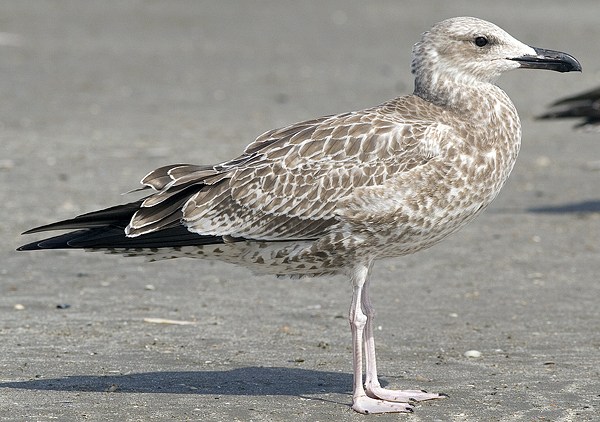
Classic structure: long exposed tibia, high breasted, elongated rear end, snouty head.
Size and structure
Caspian Gulls can be strikingly large, tall
birds, but most individuals are similar in
length and weight to Herring Gull and so do
not stand out on size alone. However, cachinnans is structurally distinctive at all ages, often described as 'lanky' or 'gangly'. It has
relatively long, thin-looking legs (the extra
length is particularly noticeable in the tibia)
and often seems to stand taller than Herring
Gull. Next to michahellis, its legs tend to look
longer and less robust. However, some michahellis are long-legged compared with
Herring Gulls, so observers should be
mindful of this when confronted with an
apparently lanky bird. There are marked differences
in size and structure between male
and female cachinnans (see Malling Olsen &
Larsson 2003) and these differences may be
more marked than for other large gulls
(Gibbins 2003). Some, presumably males, can
look incredibly long-legged, yet others, presumably
females, can actually look rather
short-legged. Consequently, birders and committees
should not automatically dismiss a
bird that lacks the textbook long-legged look.
=================================================
| TARSUS | range | average | n: |
| L.a. argentatus | |||
| adult male | 62.0-75.2 | 67.1 | 131 |
| adult female | 55.1-69.8 | 62.4 | 142 |
| first-year male | 59.4-70.3 | 66.7 | 48 |
| first-year female | 55.8-68.0 | 60.9 | 43 |
| L.a. argenteus | |||
| adult male | 56.4-70.3 | 64.1 | 52 |
| adult female | 53.3-68.6 | 59.6 | 63 |
| first-year male | 54.5-66.7 | 62.6 | 22 |
| first-year female | 52.9-64.2 | 58.5 | 22 |
| TARSUS (N Norway) | |||
| adult male | 62.5-75.0 | 67.5 | 25 |
| adult female | 57.1-68.1 | 62.2 | 21 |
| TARSUS (Finland. Estonia) | |||
| adult male | 67.0-72.0 | 69.2 | 6 |
| adult female | 57.3-66.8 | 60.6 | 7 |
| TARSUS (Denmark) | |||
| adult male | 61.6-73.6 | 66.7 | 52 |
| adult female | 53.6-70.4 | 62.8 | 55 |
| TARSUS (W Germany) | |||
| adult male | 57.0-72.0 | 65.9 | 80 |
| adult female | 52.5-67.0 | 61.2 | 80 |
| TARSUS (Sobortsk, White Sea) | |||
| - | 58.8-75.0 (rarely <70mm) | ||
| L.c. cachinnans | |||
| adult male | 65.8-77.0 | 69.9 | 30 |
| adult female | 58.7-73.8 | 64.0 | 26 |
| first-year male | 65.7-69.9 | 67.5 | 4 |
| first-year female | 57.2-66.1 | 61.1 | 4 |
The head can appear oddly small for the
body, generally looks pear-shaped, and normally
lacks the bulky feel of the head of
Herring Gull and (especially) michahellis.
The head often looks 'anorexic', as though
there is little flesh covering the skull; this
means that head shape equates more closely
to skull shape than for other large gulls. The
often-quoted, but perhaps over-emphasised,
'snouty' look is due to a combination of the
long sloping forehead and the relatively long,
slim bill, which gives the front of the head a
tapering, 'pulled-out' appearance. This
snouty look can be a striking and defining
feature, but it is important to note that not
all cachinnans show it. For a significant proportion
of (presumed) females, the bill
length is unremarkable, and, because of their
higher, more rounded heads, they may recall
Common Gull L. canus. Conversely, some
larger males can have a robust bill and a
solid, more angular head that overlaps in appearance with both Herring and Yellow-legged
Gulls. Yellow-legged Gulls typically
have a deeper, blunter bill and a larger, more
angular head, yet, as with other gulls, males
and females can be rather different, and the1
slighter individuals overlap with Herring and
even Lesser Black-backed Gulls L. fuscus. Furthermore, michahellis from the Atlantic coast
of the Iberian Peninsula tend to be smaller,
less robust and less rangy than Mediterranean
birds.
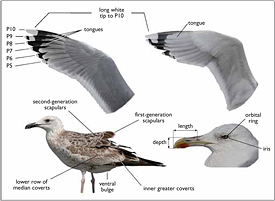 Most Caspian Gulls appear longer-billed
than Herring Gull and michahellis. They have
a more gentle, even curve to the culmen and
a less obvious gonydeal angle; unlike Herring
Gull and michahellis there is little or no
bulging at the gonys and the general impression
is of a gently tapering bill. Data in
Malling Olsen & Larsson (2003) indicate that
there is actually much overlap in the bill
length of cachinnans and Herring Gull
Most Caspian Gulls appear longer-billed
than Herring Gull and michahellis. They have
a more gentle, even curve to the culmen and
a less obvious gonydeal angle; unlike Herring
Gull and michahellis there is little or no
bulging at the gonys and the general impression
is of a gently tapering bill. Data in
Malling Olsen & Larsson (2003) indicate that
there is actually much overlap in the bill
length of cachinnans and Herring Gull
(males: Herring 46.4–64.9 mm, mean 54.6, cachinnans 50.7–63.5 mm, mean 56.3;
females: Herring 44.9–59.0 mm, mean 49.7, cachinnans 48.0–59.5 mm, mean 51.9). Thus,
the longer-billed impression given by cachinnans results from the interaction of its shape,
depth and length, accentuated in some birds
by the pear-shaped head and long neck.
Gibbins (2003) assessed the ratio between
bill length and gonys depth (measured from
photographs; length and depth as indicated
in fig. 1) in a sample of Herring and Caspian
Gulls (n = 68). Most Herring Gulls were
scored as having a ratio of 1.75–2.00 whereas
most cachinnans were scored as 2.25–2.50.
Thus for cachinnans the bill is most often
more than twice as long as its maximum
depth, while for Herring it is most frequently
a little less than twice its maximum depth.
Some cachinnans can be extremely long- and
slim-billed, with ratios up to 3.25, compared
with a maximum of 2.5 in Herring. Note that
bill deformity is not uncommon among gulls
(especially first-years), so a long, slim bill is
not, in itself, sufficient for identification or
record acceptance.
The body shape of cachinnans is subtly
distinctive. One of the most noticeable features
is the attenuated rear end; this is a consequence
of a flat back, limited or absent
tertial step and relatively long wings. The tip of the tail falls one-third to halfway along the
exposed primaries, while on Herring Gull it
usually reaches halfway or slightly further
(this comparison holds good only for birds
that are not moulting their outer primaries).
Herring Gulls and michahellis are generally
less attenuated and have a more prominent
tertial step although, especially in hot
weather, michahellis can appear to have a very
long rear end. The belly profile of cachinnans often continues behind the legs as a ventral
bulge that sags below the wings, making the underbody resemble a boat keel in shape.
This may be obvious for some birds yet not
apparent for others. At rest, compared with
Herring Gull and most michahellis, cachinnans has a higher chest, with a slightly
'bosomed' effect, as if holding its breath. This
stance is exaggerated by the long wings and
ventral bulge, which, along with the head and
bill shape, give the most typical birds an
instantly recognisable jizz.
In flight, the long- and broad-winged
appearance of cachinnans may catch the eye
of regular gull-watchers. Compared with
Herring Gull and michahellis, the greater
length of the head, bill and neck extension in
front of the wings is also noticeable.
To summarise, the most typical cachinnans have a striking jizz, much more eyecatching
than that of michahellis. They can be
a large yet elegant gull, easily located in
mixed flocks. However, some lack the rangy/gangly/snouty character usually associated
with the species and so are much less
distinctive. Weather conditions and posture
influence appearance, and in hot conditions,
when their feathers are sleeked down, cachinnans may look very slim, long-legged and
lanky. On cold
winter days they
look quite different,
and experience
from birding
holidays in the
Middle East may
not translate well
to Britain.
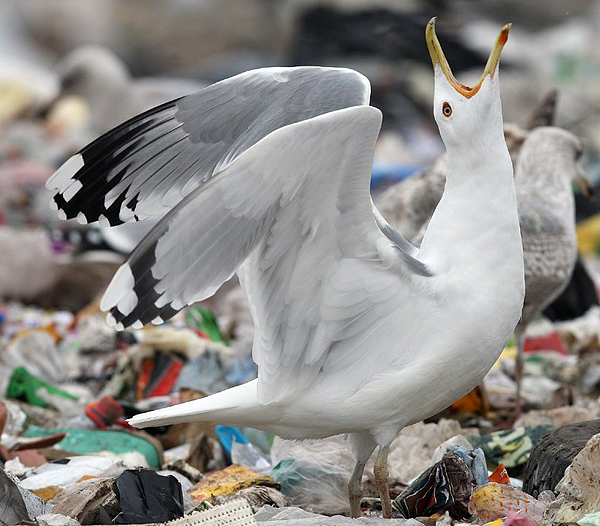
Adult Caspian Gull, Latvia, 11 Apr 2009.This large male was typically
aggressive and, as pictured here, incessantly gave the rapid, laughing call which
is diagnostic of Caspian Gull. Unlike Yellow-legged and Herring, Caspian Gulls
hold their wings open when giving the long call – the so-called 'albatross
posture'.The characteristic primary pattern is visible here: note the grey
tongues eating into the black wing-tip on the upperside of P7–10 and the
long silvery tongue on the underside of P10. Like Yellow-legged Gull, Caspian usually has a broad, black subterminal band extending unbroken across P5,
but there is much individual variation and this bird has only isolated black
marks on the outer and inner webs.
Behaviour and
voice
Caspian Gulls mix
freely with other
large gulls in both
feeding and resting
areas (plate 48).
When feeding on
rubbish dumps,
large individuals
are often extremely
aggressive (more so
than Herring and michahellis) and
dominate favoured
patches. Caspian Gulls habitually raise their wings, especially
in aggressive encounters, and this can be an
easy way to locate them in groups of feeding
gulls.
Their calls (appendix 1) also attract attention
and can be heard clearly even above the
noise created by large numbers of squabbling
Herring Gulls. The importance of the long
call and long-call posture in separating cachinnans from other large gulls has been
rather underplayed in the literature and it is
clear that not all birders are aware of their
value. Calls are always difficult to capture in
words and the long call of cachinnans has
been described in various ways. The full long
call is a loud, rapid 'haaa-haaa-haa-ha-ha-haha-
ha-ha-ha', with a characteristic nasal,
laughing quality, very different from Herring
Gull's. Once heard it is easily recognised.
Adults frequently give shorter versions of this
call (the last six or seven notes) during aggressive encounters. Evidence suggests that
the full long call takes time to develop: in
August and September, 1CY birds give a
much more subdued version (Hannu Koskinen,
pers. comm., CG pers. obs.). Juveniles
often also give screeching calls, especially when coming in to land to join a feeding
melee. These calls are very high-pitched (they
have a clear squealing quality) and, once
heard, are distinct from the whine of juvenile
Herring Gulls.
The full long call is frequently accompanied
by the 'albatross posture', with wings
open and held back and the head raised progressively
as the notes are delivered (plate
49). Herring Gulls and michahellis keep their wings closed when long-calling, so this is a
key distinction. Herring Gulls raise their
heads only to approximately 45° when longcalling,
while both cachinnans and michahellis often (but not always) raise them to
90°.
Urszulin (near Zabrodzie), Włodawa County, Lublin Voivodeship (51.4342N 23.2285E). Recorded on 2012-03-12 by: Jarek Matusiak. Colony about 32 Pairs; some birds can be hybrids among L. cachinans and L. michahellis. |
|
Góra Kalwaria (near Podłęcze), Piaseczno County, Masovian Voivodeship (52.0312N 21.2262E). Recorded on 2013-02-26 by: Jarek Matusiak. Response on White-tailed Eagle; colony of about 83 pairs; some birds can be hybrids among L. cachinnans and L. michahellis. At least 3 L. michahellis were present, and one L. f. intermedius (but silent). |
|
Rødvig havn (55.2528N 12.3737E). Recorded on 2009-10-31 by: Lars Krogh. Begging 1st winter bird. Background gulls are some L. argentatus and L. fuscus. |
END OF PART 1
 Larus cachinnans 1CY UKK L-011765 August 13 2015, Simrishamn, Sweden.
Picture: Jörgen Bernsmo.
Larus cachinnans 1CY UKK L-011765 August 13 2015, Simrishamn, Sweden.
Picture: Jörgen Bernsmo. Larus cachinnans 1CY HCL23 August 10 & October 10 2015, Kampen, the Netherlands & Kent, UK.
Picture: Cor Fikkert & Michael Southcott.
Larus cachinnans 1CY HCL23 August 10 & October 10 2015, Kampen, the Netherlands & Kent, UK.
Picture: Cor Fikkert & Michael Southcott.Ringed as pullus on May 20 2015 at Yavonov, Lviv Oblast, (westernmost) Ukraine.
 Larus cachinnans 1CY & 3CY PANX August & October 2009, Deponie Pohlsche Heide - Minden, Germany & December 2012, Herstal - Liege, Belgium.
Larus cachinnans 1CY & 3CY PANX August & October 2009, Deponie Pohlsche Heide - Minden, Germany & December 2012, Herstal - Liege, Belgium. Larus cachinnans 1CY PAPP August 28 2009, Windheim - Minden, Germany (52°24'50N, 09°01'49E).
Picture: Armin Deutsch.
Larus cachinnans 1CY PAPP August 28 2009, Windheim - Minden, Germany (52°24'50N, 09°01'49E).
Picture: Armin Deutsch. Larus cachinnans 1CY PDNZ July 25 2010, Simrishamn, Sweden. Picture: Jörgen Bernsmo.
Larus cachinnans 1CY PDNZ July 25 2010, Simrishamn, Sweden. Picture: Jörgen Bernsmo. 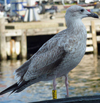 Larus cachinnans 1CY PHHL August 26 2011, Warnemünde - Mecklenburg-Vorpommern, Germany (54.10N 12.05E). Picture: Ronald Klein.
Larus cachinnans 1CY PHHL August 26 2011, Warnemünde - Mecklenburg-Vorpommern, Germany (54.10N 12.05E). Picture: Ronald Klein. Larus cachinnans 1CY-2CY PKSD August 2012 - June 2013, Minden & Dümmer, Germany.
Picture: Armin Deutsch.
Larus cachinnans 1CY-2CY PKSD August 2012 - June 2013, Minden & Dümmer, Germany.
Picture: Armin Deutsch.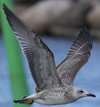 Larus cachinnans 1CY PKTE August 17 2012, Simrishamn, Sweden. Picture: Jörgen Bernsmo.
Larus cachinnans 1CY PKTE August 17 2012, Simrishamn, Sweden. Picture: Jörgen Bernsmo. 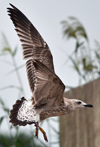 Larus cachinnans 1CY PLAH August 21 2012, Deponie Pohlsche Heide - Minden, Germany (52°23'05N, 08°46'45E).
Picture: Armin Deutsch.
Larus cachinnans 1CY PLAH August 21 2012, Deponie Pohlsche Heide - Minden, Germany (52°23'05N, 08°46'45E).
Picture: Armin Deutsch. Larus cachinnans 1CY PNDT August 30 2013, Deponie Pohlsche Heide - Minden, Germany (52°23'05N, 08°46'45E).
Picture: Armin Deutsch.
Larus cachinnans 1CY PNDT August 30 2013, Deponie Pohlsche Heide - Minden, Germany (52°23'05N, 08°46'45E).
Picture: Armin Deutsch. Larus cachinnans 1CY-2CY PNNL August 2013-February 2014, England and France. Picture: Lee Gregory & Alasin Fossé.
Larus cachinnans 1CY-2CY PNNL August 2013-February 2014, England and France. Picture: Lee Gregory & Alasin Fossé.  Larus cachinnans PNXB 1CY & 3CY, August 2013 & December 12 2015, the Netherlands & UK. Picture: N. Huig & R. van Oosteroom & Michael Southcott.
Larus cachinnans PNXB 1CY & 3CY, August 2013 & December 12 2015, the Netherlands & UK. Picture: N. Huig & R. van Oosteroom & Michael Southcott. Larus cachinnans 1CY PSSN August 29 2011, Lubna, Poland. Picture: Michal Rycak.
Larus cachinnans 1CY PSSN August 29 2011, Lubna, Poland. Picture: Michal Rycak. Larus cachinnans 1CY PUEA August 16 2010, Kolobrzeg, Poland. Picture: Ryszard Rudzionek.
Larus cachinnans 1CY PUEA August 16 2010, Kolobrzeg, Poland. Picture: Ryszard Rudzionek. 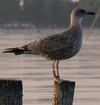 Larus cachinnans 1CY & 3CY PUHP 2010 & 2012, Miedwie lake, Poland, Simrishamn, Sweden & Friedrichshafen, Germany.
Larus cachinnans 1CY & 3CY PUHP 2010 & 2012, Miedwie lake, Poland, Simrishamn, Sweden & Friedrichshafen, Germany.  Larus cachinnans 1CY PUKZ August 18 2010, Lubna, Poland. Picture: Michal Rycak.
Larus cachinnans 1CY PUKZ August 18 2010, Lubna, Poland. Picture: Michal Rycak.  Larus cachinnans 1CY PUNP August & December 2010, Poland & Switzerland. Picture: Michal Rycak & Ernst Weiss.
Larus cachinnans 1CY PUNP August & December 2010, Poland & Switzerland. Picture: Michal Rycak & Ernst Weiss. Larus cachinnans 1CY PUST August 09 2010, Lubna, Poland. Picture: Michal Rycak.
Larus cachinnans 1CY PUST August 09 2010, Lubna, Poland. Picture: Michal Rycak.  Larus cachinnans 1CY PUTE August 09 2010, Lubna, Poland. Picture: Michal Rycak.
Larus cachinnans 1CY PUTE August 09 2010, Lubna, Poland. Picture: Michal Rycak.  Larus cachinnans 1cy PUTH August 09-10 2010, Rødvig-Stevns, Sjælland, Denmark. Picture: Lars Krogh.
Larus cachinnans 1cy PUTH August 09-10 2010, Rødvig-Stevns, Sjælland, Denmark. Picture: Lars Krogh. 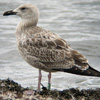 Larus cachinnans 1CY 089P August 23 2006, Stroby ladeplads, Denmark & September 26 2006, Simrishamn, Sweden. Picture: Jörgen Bernsmo & Lars Krogh.
Larus cachinnans 1CY 089P August 23 2006, Stroby ladeplads, Denmark & September 26 2006, Simrishamn, Sweden. Picture: Jörgen Bernsmo & Lars Krogh.  Larus cachinnans 1CY 129P August 04 2006, Deponie Pohlsche Heide - Minden, Germany (52°23'05N, 08°46'45E).
Picture: Armin Deutsch.
Larus cachinnans 1CY 129P August 04 2006, Deponie Pohlsche Heide - Minden, Germany (52°23'05N, 08°46'45E).
Picture: Armin Deutsch. Larus cachinnans 1CY 06P3 July 26-28 2014, Leeuwarden, the Netherlands. Picture: Jeroen Breidenbach.
Larus cachinnans 1CY 06P3 July 26-28 2014, Leeuwarden, the Netherlands. Picture: Jeroen Breidenbach.  Larus cachinnans 1CY 53P5 August 17 2015, IJmuiden, the Netherlands.
Larus cachinnans 1CY 53P5 August 17 2015, IJmuiden, the Netherlands.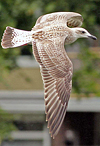 Larus cachinnans 67P6 1CY, August 24 2015, Rotterdam, the Netherlands. Picture: Merijn Loeve.
Larus cachinnans 67P6 1CY, August 24 2015, Rotterdam, the Netherlands. Picture: Merijn Loeve.  Larus cachinnans 1CY PLG DA-07404 July 14 1999, Deponie Coerde - Münster, Germany (52.00.39N 07.38.48E). Picture: Armin Deutsch.
Larus cachinnans 1CY PLG DA-07404 July 14 1999, Deponie Coerde - Münster, Germany (52.00.39N 07.38.48E). Picture: Armin Deutsch. Larus cachinnans 1CY PLG DN-24320 August 09 2007, Deponie Pohlsche Heide - Minden, Germany (52°23'05N, 08°46'45E).
Picture: Armin Deutsch.
Larus cachinnans 1CY PLG DN-24320 August 09 2007, Deponie Pohlsche Heide - Minden, Germany (52°23'05N, 08°46'45E).
Picture: Armin Deutsch.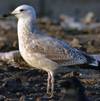 Larus cachinnans 1CY PLG DN-25430 August - October 2011, Deponie Pohlsche Heide - Minden, Germany (52°23'05N, 08°46'45E).
Picture: Armin Deutsch.
Larus cachinnans 1CY PLG DN-25430 August - October 2011, Deponie Pohlsche Heide - Minden, Germany (52°23'05N, 08°46'45E).
Picture: Armin Deutsch. Larus cachinnans 1CY-2CY PLG DN-25866 2008 & 2009, Deponie Pohlsche Heide - Minden, Germany (52°23'05N, 08°46'45E).
Picture: Armin Deutsch.
Larus cachinnans 1CY-2CY PLG DN-25866 2008 & 2009, Deponie Pohlsche Heide - Minden, Germany (52°23'05N, 08°46'45E).
Picture: Armin Deutsch. Larus cachinnans 1CY PLG DN-28035 July 21 2012, Simrishamn, Sweden. Picture: Hans Larsson.
Larus cachinnans 1CY PLG DN-28035 July 21 2012, Simrishamn, Sweden. Picture: Hans Larsson. Larus cachinnans 1CY-2CY PLG DN-28100 August 2012 - April 2013, Deponie Pohlsche Heide - Minden, Germany (52°23'05N, 08°46'45E).
Picture: Armin Deutsch.
Larus cachinnans 1CY-2CY PLG DN-28100 August 2012 - April 2013, Deponie Pohlsche Heide - Minden, Germany (52°23'05N, 08°46'45E).
Picture: Armin Deutsch. Larus cachinnans 1CY 6L48 August 14 2015, Simrishamn, Sweden.
Picture: Jörgen Bernsmo.
Larus cachinnans 1CY 6L48 August 14 2015, Simrishamn, Sweden.
Picture: Jörgen Bernsmo. 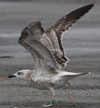 Larus cachinnans 1CY XNCA August 30 2012, Simrishamn, Sweden. Picture: Jörgen Bernsmo.
Larus cachinnans 1CY XNCA August 30 2012, Simrishamn, Sweden. Picture: Jörgen Bernsmo..jpg) Larus cachinnans 1CY VL5S August 23 2011, Kerteminde, Denmark. Picture: Kjeld Tommy Pedersen ringing team.
Larus cachinnans 1CY VL5S August 23 2011, Kerteminde, Denmark. Picture: Kjeld Tommy Pedersen ringing team. Larus cachinnans 1CY SVS 90A71627 August & November 2010, Sweden & the Netherlands. Picture: Anders Åkesson & Ruud Altenburg.
Larus cachinnans 1CY SVS 90A71627 August & November 2010, Sweden & the Netherlands. Picture: Anders Åkesson & Ruud Altenburg. Larus cachinnans 1cy, August 2008, Riga, Latvia. Picture: Chris Gibbins.
Larus cachinnans 1cy, August 2008, Riga, Latvia. Picture: Chris Gibbins. Larus cachinnans 1cy, August 2008, Riga, Latvia. Picture: Chris Gibbins.
Larus cachinnans 1cy, August 2008, Riga, Latvia. Picture: Chris Gibbins. Larus cachinnans 1cy, August 23 2008, IJmuiden, the Netherlands. Picture: Mars Muusse.
Larus cachinnans 1cy, August 23 2008, IJmuiden, the Netherlands. Picture: Mars Muusse. Larus cachinnans 1cy, August 30 2007, Westkapelle, the Netherlands. Picture: Ies Meulmeester.
Larus cachinnans 1cy, August 30 2007, Westkapelle, the Netherlands. Picture: Ies Meulmeester. Larus cachinnans 1cy, 15 August 2012, Barneveld, the Netherlands. Picture: Herman Bouman.
Larus cachinnans 1cy, 15 August 2012, Barneveld, the Netherlands. Picture: Herman Bouman.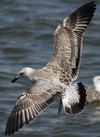 Larus cachinnans 1cy, 25 July 2012, Utrecht, the Netherlands. Picture: Herman Bouman.
Larus cachinnans 1cy, 25 July 2012, Utrecht, the Netherlands. Picture: Herman Bouman. 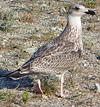 Larus cachinnans 1cy, August 2011, Gelendzjik, Kraj Krasnodar, Russia. Picture: Potatoes_Ru.
Larus cachinnans 1cy, August 2011, Gelendzjik, Kraj Krasnodar, Russia. Picture: Potatoes_Ru. Larus cachinnans 1CY, August 15 2012, Barneveld, the Netherlands. Picture: Maarten van Kleinwee.
Larus cachinnans 1CY, August 15 2012, Barneveld, the Netherlands. Picture: Maarten van Kleinwee. Larus cachinnans 1CY, July 29 2007, Karrebæksminde, Sjælland, Denmark. Picture: Lars Adler Krogh & Frank Abrahamson.
Larus cachinnans 1CY, July 29 2007, Karrebæksminde, Sjælland, Denmark. Picture: Lars Adler Krogh & Frank Abrahamson. Larus cachinnans 1CY, July 26 2010, Damhussøen - København, Denmark. Picture: Klaus Malling Olsen.
Larus cachinnans 1CY, July 26 2010, Damhussøen - København, Denmark. Picture: Klaus Malling Olsen.  Larus cachinnans 1CY, August 22 2007, Salthammer odde, Bornholm, Denmark. Picture: Sune Riis Sørensen.
Larus cachinnans 1CY, August 22 2007, Salthammer odde, Bornholm, Denmark. Picture: Sune Riis Sørensen.  Larus cachinnans 1cy, July 24 2013, Katwijk, the Netherlands.
Larus cachinnans 1cy, July 24 2013, Katwijk, the Netherlands. Larus cachinnans 1cy, July 24 2013, Katwijk, the Netherlands.
Larus cachinnans 1cy, July 24 2013, Katwijk, the Netherlands.